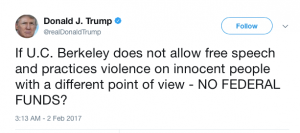In January 2018, I attended the Association of American Colleges and Universities’ (AAC&U) annual conference to gain a deeper understanding of how university administrators and faculty are talking about the recent attacks on academic freedom on college campuses in the name of the first amendment. A theme around student protest emerged again and again during the many panel discussions on the first amendment on college and university campuses. Here I reflect on how student protest is framed, and how a sociological analysis of power can add to the conversation.
In her piece on the right’s “weaponization” of free speech, Joan Scott (2018) contends that in this current time: “The university as a place for critical thinking, for difficult dialogue and frank, open debate, has been damaged.” She goes on to say that such damage is not simply the result of different subject matter in higher education curricula, but a political choice within the context of the neoliberal university. Rather than encouraging students to engage in debate, colleges and universities tend to encourage students to stay away from difficult subject matter in the name of career preparation. Simultaneously, a resurfaced anti-intellectualism that disregards the importance of academic freedom threatens our mutual capacity for democracy.
This past year, a number of highly-publicized college campus protests flooded millions of social media feeds and TV screens across the country. These protests were against controversial, explosive speakers, Charles Murray at Middlebury College and Milo Yiannopolous at University of California (UC) Berkeley, to name a few. Media frenzy brought free speech debates to the forefront of what was already an ongoing national conversation, especially among college and university campus communities. These protests also became highly politicized. Donald Trump’s tweets, for example, threatened to withhold federal funding from UC Berkeley. With this climate as backdrop, the 2018 AAC&U conference hosted a number of free speech and critical inquiry themed panels and seminars.
Throughout the various free speech panel sessions, I found that speakers, facilitators, and participants mainly addressed three themes: constitutional law, moral obligations of campus communities to uphold respectful dialogue, and student conduct when controversial speakers were headlining an event.
Constitutional law scholars clarified the limits and bounds of the first amendment throughout the sessions. Ethics experts spoke on the need for education on civil discourse methods to resist the backlash of using disruptive methods of protest. Journalists argued that the realities on campuses responding to controversial or provocative speakers is often much more civil than the many media reports suggest.
However, somewhat lost in the conversations from my view were students’ concerns that drove protest (whether deemed violent or not), save for a few voices such as sociologist Linus Owens of Middlebury College. Conversations intended to foster dialogue about best practices in creating democratic and safe campuses focused on the form of student protest rather than the content of protest or the context in which students engage in protest to begin with.
As sociologists, we continuously question, observe, and theorize how social inequality transforms our communities. Sociology makes clear that social stratification is not always overt, and is embedded in our interactions and social structures (Giddens 1990; Mooney-Nickel 2013); at the same time, merit and fairness can elevate certain voices over others (Khan 2016). In the context of debating first amendment rights on campus, speakers such as Milo Yinnapolous and Richard Spencer are supported through vast funding networks. During one panel discussion about free speech and critical inquiry, Scott Jaschik of Inside Higher Ed argued that provocative speakers on college campuses are not new. What is new is the amount of money spent on these speakers, and the outside funding networks that use student groups to promote provocative speakers on campuses. For this reason, the marketplace of ideas is skewed in favor of provocateurs.
The limits of a constitutional law or ethics argument could be extended by a sociological analysis of networks, power, and the expanse of inequality that could potentially contribute to frustration and protest, even as colleges and universities are changing rapidly. For instance, many students are paying more in tuition, but seeing less support by institutions of higher education (Mitchell, Leachman, and Masterson 2017). This reality that contributes to tensions on campuses and unequally gives power and voice to outside influences to reshape campus life often also frequently weakens free speech debates in the context of student demands for corrective actions from administrations.
Sociologists can take a significant role in blunting the right’s “weaponized” free speech blade by using our methods and theory to bridge conversations and re-center student voices in three ways. First, sociologists can promote a more dynamic dialogue as to how constitutional law posits equal access to free speech on structurally stratified grounds. Second, sociology’s tradition of power analysis can contextualize explosive speakers as richly funded provocateurs rather than egalitarian colleagues in the marketplace of ideas. Finally, sociologists can challenge the politicized and grossly reductionist notion that college students are immature and coddled, in need of discipline. Rather, the sociological gaze should focus our attention on how a robust education fosters our collective right to citizenship.
References
Giddens, Anthony. 1990. Consequences of Modernity. Cambridge: Polity Press.
Khan, Shamus R. 2011. Privilege: The Making of an Adolescent Elite at St. Paul’s School. Princeton: Princeton University Press.Mitchell, Michael,
Michael Leachman, and Kathleen Masterson. 2017. “A Lost Decade in Higher Education Funding: State Cuts Have Driven Up Tuition and Reduced Quality.” Center on Budget and Policy Priorities. Retrieved January 10, 2018 (https://www.cbpp.org/sites/default/files/atoms/files/2017_higher_ed_8-22-17_final.pdf).
Mooney-Nickel, Patricia. 2013. Public Sociology and Civil Society: Governance, Politics, and Power. Boulder, CO: Paradigm Publishers.
Owens, Linus, Maya Goldberg-Safir, and Rebecca Flores Harper. 2017. “Divisiveness Is Not Diversity.” Retrieved January 19, 2018 (http://www.insidehighered.com/views/2017/03/17/professor-and-two-former-students-say-why-they-think-students-are-protesting).
Scott, Joan W. 2018. “How the Right Weaponized Free Speech.” Retrieved January 11, 2018 (https://www.chronicle.com/article/How-the-Right-Weaponized-Free/242142).

